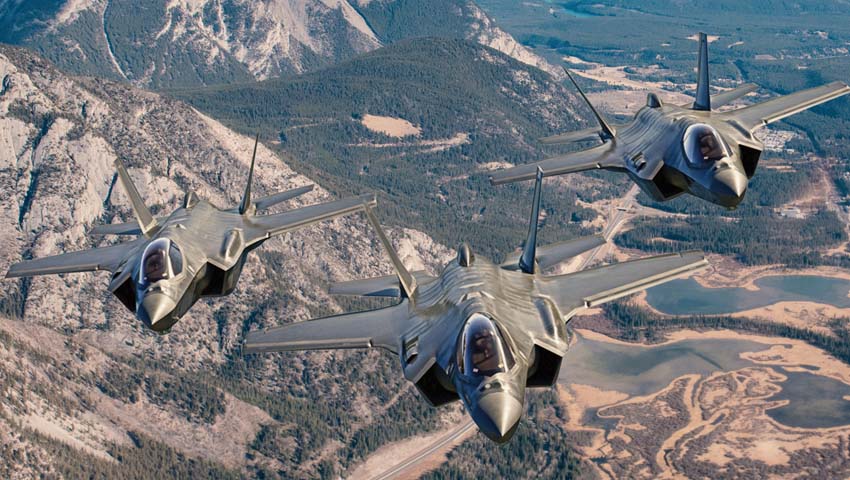Lockheed Martin has once again offered the fifth-generation F-35 Joint Strike Fighter to replace the Royal Canadian Air Force’s ageing fleet of CF-18 Hornets as part of a competitive process.
To continue reading the rest of this article, please log in.
Create free account to get unlimited news articles and more!
Canada’s relationship with the multibillion-dollar F-35 Joint Strike Fighter Program has been one of heady highs and tumultuous lows, with the Conservative government led by Stephen Harper committing the nation to acquiring 65 airframes to replace the ageing 80 CF-18 Hornets in 2010.
However, the election of Liberal Party Prime Minister Justin Trudeau in 2015 spelt doom for the country’s participation in the F-35 program, with the Prime Minister declaring not to purchase the F-35, instead focusing on “one of the many, lower-priced options that better match Canada’s defence needs”.
In 2018, Canada officially began their competitive process to replace the Royal Canadian Air Force fleet of CF-18 aircraft. The Canadian government plans to procure 88 jets to replace its CF-18 fleet. We anticipate the Canadian government will make their fighter selection in this competitive process in early 2021.
This resulted in a multi-horse race to replace the Royal Canadian Air Force’s ageing CF-18s, drawing competitors including the Eurofighter Typhoon, the Boeing F-18 E/F Super Hornet, Saab’s Gripen and, of course, the Lockheed Martin F-35 Joint Strike Fighter.
Canada has been a partner since the inception of the Joint Strike Fighter competition in 1997. In 2006, Canada joined the United States, United Kingdom, the Netherlands, Denmark, Australia, Turkey, Italy and Norway in a memorandum of understanding for the “Production, Sustainment and Follow-On Development” of the F-35.
Canada, like Australia, has enjoyed a boost to local competitive aerospace manufacturing as part of its participation in the multibillion-dollar program, with Canadian companies taking part in contracts worth an expected value of US$1.1 billion between the 2013 and 2023 time frame – with a total potential value of Canada’s involvement in the JSF program worth an estimated US$9.9 billion in 2013.
Another hurdle was a new requirement that the winning fighter must show it would be integrated into the joint US-Canadian air defence system NORAD.
On July 31, Lockheed Martin and the United States government submitted its request for proposal response to the Canadian government for the Future Fighter Capability Project.
Greg Ulmer, vice president and general manager of the F-35 Lightning II, said, “I am proud of the F-35’s partnership with Canada. Over the last few decades, Canada has been an integral role in the F-35’s development. The F-35 will provide exceptional capabilities and strength to the Royal Canadian Air Force.
Like its introduction with the Royal Australian Air Force and allied air forces around the globe, the F-35 is expected to “transform the Royal Canadian Air Force fleet”, providing the capabilities necessary to safeguard Canadian skies. The unique mix of stealth and sensor technology will enable the Royal Canadian Air Force to modernise its contribution to NORAD operations, ensure arctic sovereignty and meet increasingly sophisticated global threats.
“Today, it is an honour for the men and women of Lockheed Martin to submit our proposal to the Canadian government. I look forward to their decision,” Ulmer added.
The Lockheed Martin F-35 Joint Strike Fighter is billed as a catalyst for the fifth-generation revolution, changing the face and capability of the Royal Australian Air Force and the wider Australian Defence Force.
Ten nations are currently flying F-35s, including the US, UK, Italy, Norway, Israel and Japan. The first of Australia’s F-35A aircraft are now based on home soil after a period of training and development at Luke Air Force Base in Arizona, USA, plus an epic Pacific Ocean crossing in December 2018.
More than 340 F-35s are operating today with partner nations; more than 700 pilots and 6,500 maintainers have been trained, and the F-35 fleet has surpassed more than 170,000 cumulative flight hours.
Over the coming years, Australia will purchase 72 of the advanced fifth-generation fighter aircraft as part of the $17 billion AIR 6000 Phase 2A/B program – which is aimed at replacing the ageing F-18A/B Classic Hornets that have been in service with the RAAF since 1985.

 Login
Login







